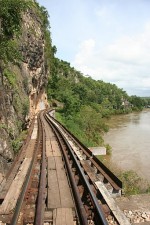 You’ve probably seen the 1957 move The Bridge On the River Kwai, but you might not know how much of the film was real and how much was fictionalized. The real history of how the railway between Burma and China was built, including the bridge, is a horrific story. The British didn’t build the railway in the 19th century because it would be too expensive. During World War II, the invading Japanese took on the project, but expected it to take five years to complete. Those plans were drawn before they found a source of free labor: the Allied POWs. Because of the inhuman amount of labor forced on the prisoners, the railway line that was expected to take five years to complete was ready in only 16 months.
You’ve probably seen the 1957 move The Bridge On the River Kwai, but you might not know how much of the film was real and how much was fictionalized. The real history of how the railway between Burma and China was built, including the bridge, is a horrific story. The British didn’t build the railway in the 19th century because it would be too expensive. During World War II, the invading Japanese took on the project, but expected it to take five years to complete. Those plans were drawn before they found a source of free labor: the Allied POWs. Because of the inhuman amount of labor forced on the prisoners, the railway line that was expected to take five years to complete was ready in only 16 months.Starvation provisions, overloading of work, dismal or absent accommodation and sanitation, and the individual viciousness of Japanese and Korean engineers and guards, took their expected toll. Disease (predominantly dysentery, malaria, beriberi and cholera), brutality (69 men were beaten to death by their guards) and 12 to 18 hour daily work shifts made for a high death rate. In fact, the work went on 24 hours a day with the aid of oil pot lamps and bamboo/wood fires that were kept burning all night long. When looking down on the wok area at night it looked like working in the “jaws of hell” – thus the workers gave it the name “Hellfire Pass”.
Read the rest of the story at Environmental Graffiti.

No comments:
Post a Comment